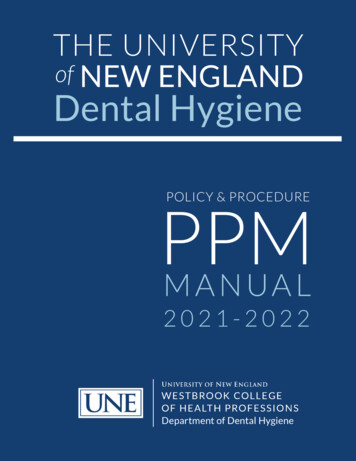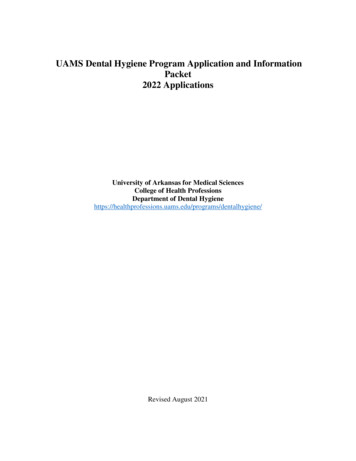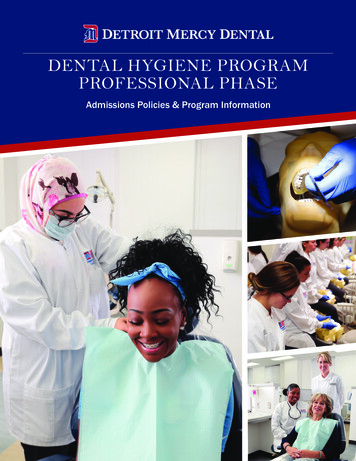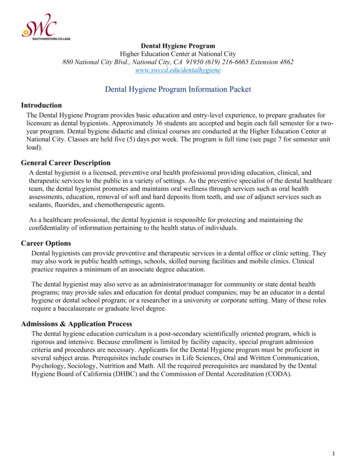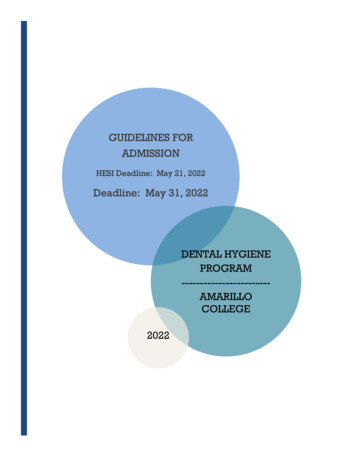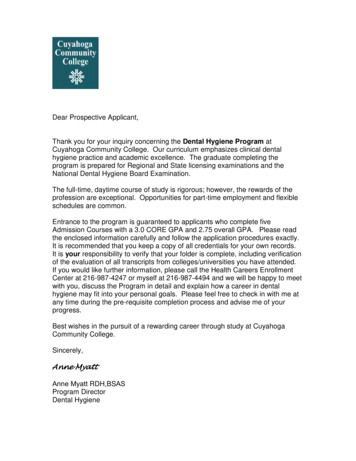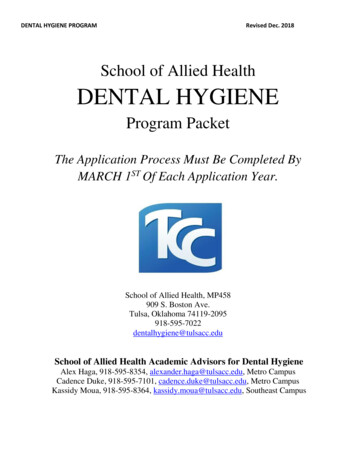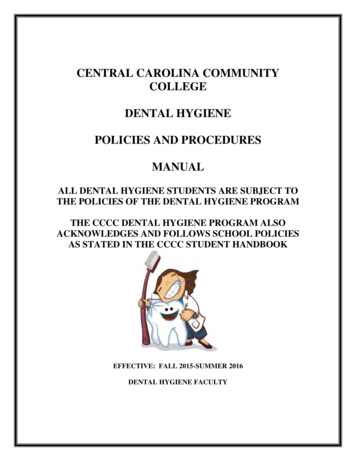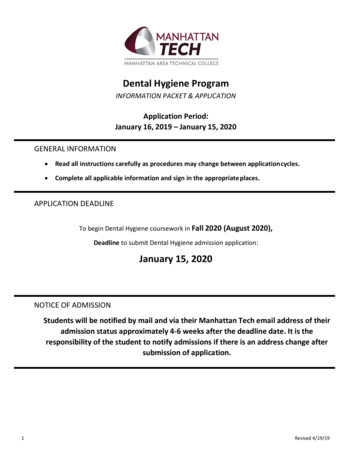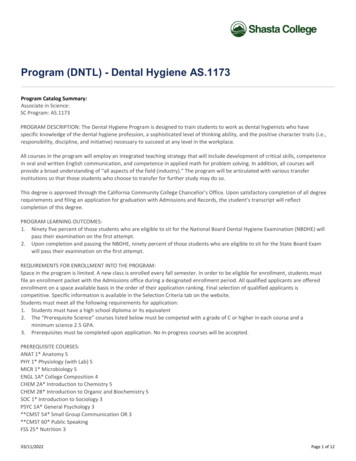
Transcription
Program (DNTL) - Dental Hygiene AS.1173Program Catalog Summary:Associate in Science:SC Program: AS.1173PROGRAM DESCRIPTION: The Dental Hygiene Program is designed to train students to work as dental hygienists who havespecific knowledge of the dental hygiene profession, a sophisticated level of thinking ability, and the positive character traits (i.e.,responsibility, discipline, and initiative) necessary to succeed at any level in the workplace.All courses in the program will employ an integrated teaching strategy that will include development of critical skills, competencein oral and written English communication, and competence in applied math for problem solving. In addition, all courses willprovide a broad understanding of “all aspects of the field (industry).” The program will be articulated with various transferinstitutions so that those students who choose to transfer for further study may do so.This degree is approved through the California Community College Chancellor’s Office. Upon satisfactory completion of all degreerequirements and filing an application for graduation with Admissions and Records, the student’s transcript will reflectcompletion of this degree.PROGRAM LEARNING OUTCOMES:1. Ninety five percent of those students who are eligible to sit for the National Board Dental Hygiene Examination (NBDHE) willpass their examination on the first attempt.2. Upon completion and passing the NBDHE, ninety percent of those students who are eligible to sit for the State Board Examwill pass their examination on the first attempt.REQUIREMENTS FOR ENROLLMENT INTO THE PROGRAM:Space in the program is limited. A new class is enrolled every fall semester. In order to be eligible for enrollment, students mustfile an enrollment packet with the Admissions office during a designated enrollment period. All qualified applicants are offeredenrollment on a space available basis in the order of their application ranking. Final selection of qualified applicants iscompetitive. Specific information is available in the Selection Criteria tab on the website.Students must meet all the following requirements for application:1. Students must have a high school diploma or its equivalent2. The “Prerequisite Science” courses listed below must be competed with a grade of C or higher in each course and aminimum science 2.5 GPA.3. Prerequisites must be completed upon application. No in-progress courses will be accepted.PREREQUISITE COURSES:ANAT 1* Anatomy 5PHY 1* Physiology (with Lab) 5MICR 1* Microbiology 5ENGL 1A* College Composition 4CHEM 2A* Introduction to Chemistry 5CHEM 2B* Introduction to Organic and Biochemistry 5SOC 1* Introduction to Sociology 3PSYC 1A* General Psychology 3**CMST 54* Small Group Communication OR 3**CMST 60* Public SpeakingFSS 25* Nutrition 303/11/2022Page 1 of 12
*May be used to fulfill General Education requirements.** OR CMST 10 if completed with a grade of C or higher during or prior to Spring 2014.TOTAL PREREQUISITE UNITS 41HEALTH & SAFETY CLINICAL CLEARANCE:Upon acceptance for enrollment, students must meet additional clinical requirements. All students participating in clinicalexperiences must submit proof of immunity of specific immunizations or serum titers, cleared criminal background check,negative drug screen, current physical examination and negative TB screening, and provide current valid Basic Life SupportHealth Care Provider card (CPR) which includes adult, child & infant resuscitation with two person rescue and AED training).Students are financially responsible for meeting these requirements according to established program process. Specificinformation is available on the Health and Safety Requirements tab on the website or students may call the Division Office (530339-3600)GRADUATION REQUIREMENTS:Students must graduate from the Dental Hygiene Program to be eligible to take the state licensing examination. Due to the timecommitments of the program, it is strongly recommended that students complete the following additional requirements forgraduation before beginning dental hygiene courses: Completion of the Humanities requirement. Completion of competence in mathematics. MATH 102 Intermediate Algebra or MATH 110 Essential Math are theadvised courses for meeting this requirement. Completion of the multi-cultural awareness requirement. Completion of computer literacy.DEGREE REQUIREMENTS:Students must be enrolled in the Dental Hygiene Program in order to take the courses listed below. Students must showcompetence in all semester courses (with a grade of C or better) in order to progress through the curriculum. A failing grade inany theory or clinical course within a semester will require withdrawal or result in failure from the program.CORE COURSES:DNTL 10 Oral Biology 3DNTL 11 Oral Radiology 3DNTL 12 Head and Neck Anatomy 2DNTL 13 Dental Health Education/Seminar 2DNTL 14 Introduction to Clinic 4DNTL 20 Local Anesthesia and Nitrous Oxide 2DNTL 21 General and Oral Pathology 4DNTL 23 Patient Management and Geriatrics 2DNTL 24 Clinical Practice I 4DNTL 25 Clinic I Seminar 2DNTL 26 Nutrition in Dentistry 1DNTL 30 Periodontology I 3DNTL 31 Pharmacology 2DNTL 32 Dental Materials 2DNTL 33 Advanced Clinical Topics 2DNTL 34 Clinical Practice II 4DNTL 35 Clinic II Seminar 1DNTL 40 Periodontology II 1DNTL 41 Practice and Financial Management 1DNTL 42 Clinic III Seminar 2DNTL 43 Clinical Practice III 4DNTL 44 Community Oral Health 3DNTL 45 Ethics and Jurisprudence 2TOTAL MAJOR UNITS: 56*May be used to fulfill General Education requirements.03/11/2022Page 2 of 12
ASSOCIATE IN SCIENCE DEGREE REQUIREMENTS:Major97Additional General Education6 GeneralElectives0Degree Total103**Note: Calculation assumes a student will double-count the Multicultural graduation requirement with either a social science orhumanities G.E. requirement and that the student will fulfill computer literacy through a test. If students plan well and see acounselor, they may be able to double count the Multicultural and Computer Literacy units. If these graduation requirements areadded, the number of units is increased by 6 units.Fall 2019PRIOR PROGRAM REVIEW REFLECTION (If applicable)Term and Year of Previous Review: Fall 2014Discuss any changes to the program as a result of the previous program review: The program faculty have continued to attendprofessional development conferences and workshops related to clinical practice, teaching methodologies including use ofsimulation, classroom, and social communication technologies to promote student learningResources Received or Requested: California Dental Hygiene Educators Conferences ( 9000.00 depending on location)CURRENT PROGRAM REVIEWSummarize participation comments: Charles CortAlignment with Mission: Describe how the program contributes to the Shasta College Mission: The Shasta College DentalHygiene program faculty and course offerings support student success as described in the Shasta College Mission Statement:Critical Thinking: The dental hygiene student graduate will have the ability to comprehend and communicate and engage inproblem solving as related to the dental hygiene professionEffective Communication: The dental hygiene student graduate will effectively communicate with associate dental andhealthcare professionals as required in the dental hygiene profession.Self-Efficacy: The Dental Hygiene student graduate will have the confidence and ability to perform the courses of actionrequired of a licensed health care provider.Workplace Skills: The Dental Hygiene student graduate will have the workplace skills and ethical understanding required by theDental Hygiene Board of California.Discuss some of the program successes and benefits to the students and/or community: Since the last report in 2011 theShasta College Dental Hygiene program has successfully graduated 105 students. The success rates for the national licensingexamination is 99% with 104 out of a total of 105 successfully passing the American Dental Association (ADA) written nationalboard exam. During the same reporting period the success rates for state clinical examinations is 100% with 105 out of a totalof 105 passing their respective state licensure exams.List each PLO and write a brief narrative summary analysis discussing outcomes for each of them:PLO 1: Graduates will successfully complete all necessary coursework and in so doing certify eligibility for the National BoardDental Hygiene ExaminationOutcomes: 105 out of 105 students have successfully completed all the necessary coursework to become eligible for theNational Board Dental Hygiene ExaminationPLO 2: Graduates will successfully complete all clinical coursework and in so doing certify eligibility for application to a state orregional clinical examinations.Outcomes: 105 out of 105 students have successfully completed all the necessary coursework to become eligible for state orregional clinical examinationsPLO 3: Graduates will successfully complete all coursework applicable to ethics or law examinations for state licensure.Outcomes: 105 out of 105 students have successfully completed all the necessary coursework to become eligible for ethics orlaw examinations.PLO 4: Graduates will successfully complete all coursework, licensing exams and meet the specific requirements that predictlicensure for professional dental hygiene practiceSummary: 105 out of 105 students have successfully completed all the necessary coursework and have met the specificrequirements and have become licensed dental hygienists.Describe how this program supports a transfer pathway to CSU or UC: All of the prerequisite and requisite courses required bythe program support and are directly transferable to the CSU and UC institutions of higher learning. Health Science andUniversity Program Counselors provide direct support to students seeking a bachelorette or advanced degree.03/11/2022Page 3 of 12
Specify Labor Market Demand (for CTE programs): Employment opportunities for licensed dental hygienists remain strong in2019. 100% of those college graduates in the time period of 2014 through 2018 are employed as either full or part timeprofessionals relative to personal need. The Employment Development Department of the State of California estimated agrowth of employment increase of 16.5% between the years 2016 and 2026.PROGRAM DATA ANALYSISProgram Effectiveness: The total number of student applicants accepted into the Shasta College Dental Hygiene program wasreduced in 2018 from its previous 14 total to current 12. The Dental Hygiene Board of California (DHBC) and the Commission onDental Accreditation (CODA) reduced clinical student / faculty oversight ratios to a 1-5 for all pre-clinical and clinical courses.Previously, faculty oversight was to include only those students providing direct clinical care to patients. A revised interpretationby both entities has now included student assistants as part of the mandated direct faculty oversight calculation. The revisedmandate has dictated that Shasta College Dental Hygiene reduce their total number of applicants from 14 to 12 to remaincompliant with the DHBC and CODA regulations. This will reduce the total number of those students declaring and completingthe dental hygiene program but will not negatively affect relative student success.Course Success Rates: The five year average in the reporting years 2014 – 2019 evidence a 98.15 success rate of those studentsentering the dental hygiene program. The program comprises 23 total courses which are sequential in building in a step-wiseprocess the professional understanding and skill required for national and state board examinations. The first semester includesDental 10, 11, 12, 13, and 14 which are the foundational theory and clinical courses that prepare students for patient care. Eachincorporate lecture and or lab components that introduce students to essential theories and or process techniques related tosafe and effective patient care. The five introductory courses have historically proven to be the most challenging as studentsgrapple with, what is for many, their first full-time didactic load and to acclimate to the rigors of the professional program. Inthat, most student’s drops from the program occur in the first of the four semesters.Course Retention Rates: The dental hygiene program consists of four consecutive semesters. The first semester is inherently themost difficult and accounts for the highest percentage of failure. Historically, once the cohort passes the first semester of corecurriculum the retention rates improve for all students improve. First semester retention during the five year reporting cycledemonstrates a 95.8% retention, second semester 98.5%, third 100% and lastly fourth which is also 100%. Professionaleducation standards are dictated by the Commission on Dental Accreditation (CODA), and the Dental Hygiene Board of California(DHBC) and competencies may not be altered or reduced by any public or privately accredited institution.Course Enrollments: Program enrollment to the program has remained at a positive constant. Traditionally the programreceives more than forty five applicants for the twelve spaces available.Equity: The dental hygiene profession has a predominant number of female applicants that approximates 95% of all qualifiedapplicants. Slight fluctuations occur but the mean average remains at 95% female throughout the five year reporting cycle.Likewise, those listed as White predominate those graduates in the program at 66% followed by Hispanic at 17%, Two or Moreraces 6%, Asians 3% followed by all other race categories. Age demographics are also traditionally static with 62% of allgraduates 24 years of age or less consistent in the reporting period.CURRICULUMReview of courses with prerequisites: Prerequisite courses are dictated by the Commission on Dental Accreditation (CODA) andthe Dental Hygiene Board of California (DHBC) and are reviewed annually. In addition, the programs curriculum is mandatorilyreviewed by the dental hygiene program director and submitted to the Commission on Dental Accreditation for review. Lastly,every facet of the programs’ curriculum, clinical processes as well as the facility itself is mandatorily reviewed every seven yearsby the Commission.Challenges to offering key courses: Prerequisite courses are dictated by the Commission on Dental Accreditation (CODA) and theDental Hygiene Board of California (DHBC).Course changes: There have been no changes to titles or program related courses.SUMMARYChanges or improvements needed based on the analysis above: Both prerequisite and requisite courses are mandated by theCommission on Dental Accreditation and the Dental Hygiene Board of California which dictates that change is not likely for theforeseeable future.Note any resources you intend to request through the Area Planning process to improve the program: The funding of facultytraining will remain the highest priority for the Shasta College Dental Hygiene Program. Faculty must receive both continuingeducation and monthly meetings to ensure calibrated oversight and excellence of education.Other information/reflections on the program: The Shasta College Dental Hygiene is scheduled to re-accredited in 2022.Support from administration would aid the process.Conclusion: The Shasta College Dental Hygiene Program is approaching its twentieth year anniversary (2020). The program ishighly respected in the professional community. Student graduates are sought for their professional competence and expertisethroughout the north state.03/11/2022Page 4 of 12
**BELOW TO BE COMPLETED BY THE PROGRAM REVIEW COMMITTEE**03/11/2022Page 5 of 12
PROGRAM AWARDSAward TypeProgram Type2014-152015-162016-172017-182018-19Associate or ScienceDental Hygiene12131513131213151313Grand Total03/11/2022Page 6 of 12
COURSE STATISTICSAcademic 1Capacity1616161615Census Enrl1415151512# SectionsFill ec00000ITV Secondary00000# Sections22222Capacity1616161615Census Enrl1415151512Fill ec00000ITV Secondary00000# Sections11111Capacity1616161615Census Enrl1415151512Fill ec00000ITV Secondary00000# Sections11111Capacity1616161615Census .01.00.8FTEF0.10.10.10.10.1Fill .00DualEnrlSec00000OnlineSec00000ITV Secondary00000WSCH03/11/2022Page 7 of 12
DNTL-14# Sections23333Capacity1616151515Census 04.04.03.2FTEF0.71.01.01.01.0Fill 096.00DualEnrlSec00000OnlineSec00000ITV Secondary00000# Sections22222Capacity1616161516Census Enrl1315141411WSCHDNTL-20Fill ec00000ITV Secondary00000# Sections11111Capacity1616161516Census Enrl131514141181.3%93.8%87.5%93.3%68.8%Fill 23DualEnrlSec00000OnlineSec00000ITV Secondary00000# Sections11111Capacity1616161616Census Enrl1315141411Fill 000OnlineSec00000ITV Secondary00000# Sections22222Capacity1616161516Census Enrl1315141411Page 8 of 12
Fill lineSec00000ITV Secondary00000# Sections11111Capacity1616161616Census .90.90.7FTEF0.10.10.10.10.1Fill .00DualEnrlSec00000OnlineSec00000ITV Secondary00000# Sections11111Capacity1616161616Census Enrl1315141411WSCHDNTL-26Fill ec00010ITV Secondary00000# Sections11111Capacity1616161615Census Enrl1113151413Fill ec00000ITV Secondary00000# Sections11111Capacity1616161615Census Enrl1113151413Fill .00.90.8FTEF0.10.10.10.10.1Page 9 of 12
0000000ITV Secondary00000# Sections11112Capacity1616161616Census c00000ITV Secondary00000# 10.1Fill .00DualEnrlSec00000OnlineSec00000ITV Secondary00000# Sections22222Capacity1616161616Census Enrl1113151413WSCHFill 00000ITV Secondary00000# Sections11111Capacity1616161615Census Enrl111315141368.8%81.3%93.8%87.5%86.7%Fill DualEnrlSec03/11/20226.80Census ll RateDNTL-335.5Page 10 of 12
DNTL-40OnlineSec00000ITV Secondary00000# Sections11111Capacity1616161616Census Enrl1213151413Fill ec00000ITV Secondary00000# Sections11111Capacity1616161516Census Enrl1213151413Fill ec00000ITV Secondary00000# Sections22222Capacity1616161516Census .91.81.6FTEF0.40.40.40.40.4Fill .00DualEnrlSec00000OnlineSec00000ITV Secondary00000# Sections22222Capacity1616161516Census Enrl1213151413WSCHDNTL-43Fill Sec00000OnlineSec00000ITV Secondary00000# Sections11111Page 11 of 12
Capacity1616161616Census Enrl1213151413Fill ec00000ITV Secondary00000# Sections11111Capacity1616201516Census Enrl121315141375.0%81.3%75.0%93.3%81.3%Fill F6.06.57.57.06.524.0026.0030.0028.0026.00WSCHGrand TotalDualEnrlSec00000OnlineSec00000ITV Secondary00000# Sections3031313132Capacity368368371360359Census Enrl286321339327282Fill DualEnrlSec00000OnlineSec00010ITV Secondary00000Page 12 of 12
Program (DNTL) - Dental Hygiene AS.1173. Program Catalog Summary: Associate in Science: SC Program: AS.1173 . PROGRAM DESCRIPTION: The Dental Hygiene Program is designed to train students to work as dental hygienists who have specific knowledge of the dental hygiene profession, a sophisticated level of thinking ability, and the positive character traits (i.e., responsibility, discipline, and .
